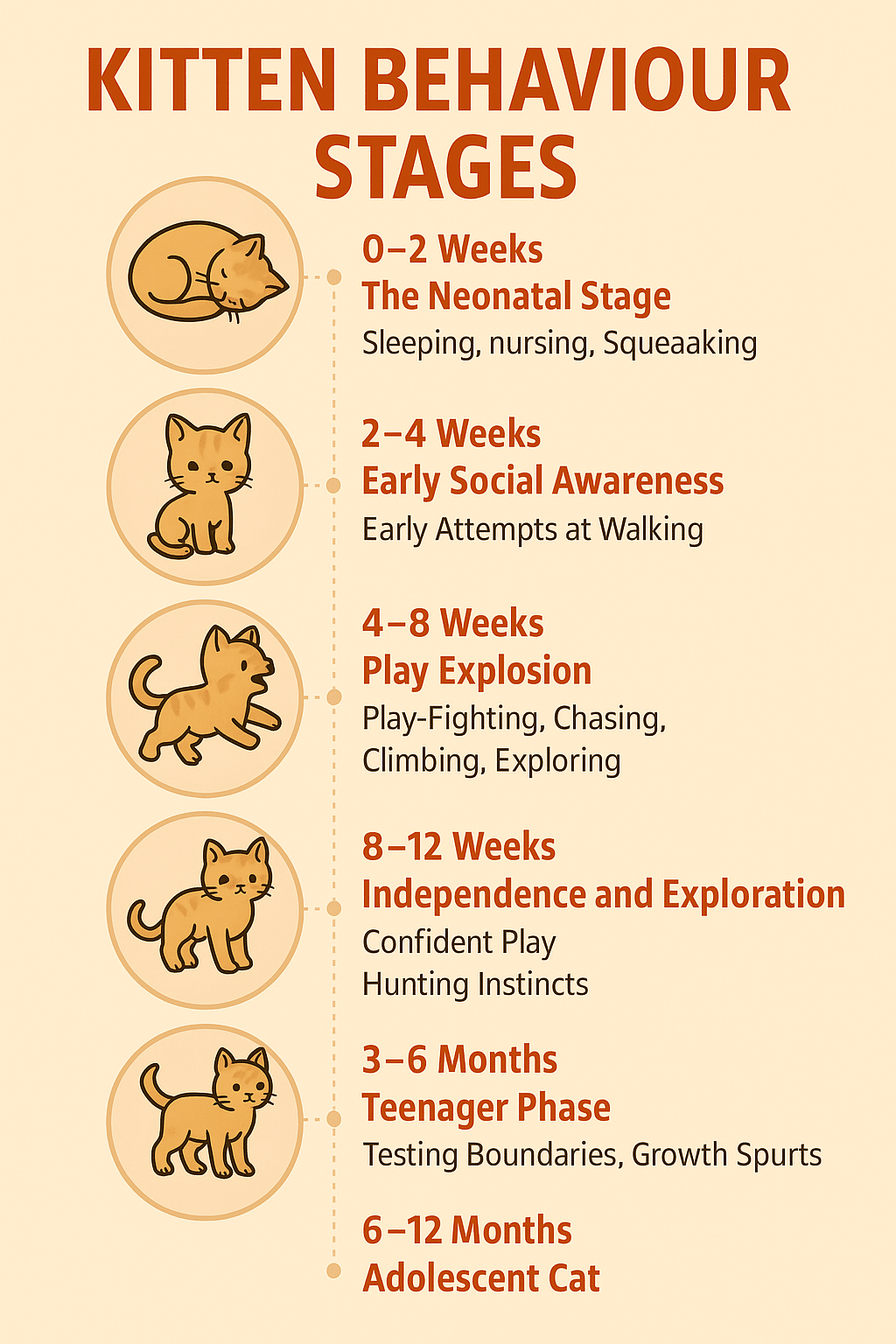Post Disclaimer
Catopedea shares information for educational and general interest purposes only. Our content is not a substitute for professional veterinary advice, diagnosis, or treatment. Always consult a licensed veterinarian for concerns about your cat’s health, diet, or behavior.
Kittens are curious, mischievous, and endlessly entertaining. But if you’ve recently welcomed one into your home, you’ve probably realized that their behaviour can be both adorable and puzzling. From climbing curtains to pouncing on toes, kittens are full of energy and personality. Understanding kitten behaviour is the key to raising a healthy, well-adjusted cat.
In this in-depth guide, we’ll break down the stages of kitten behavior, explain what’s considered normal, and give practical tips for handling problem behaviors before they become habits.
Why Understanding Kitten Behavior Matter
Many new cat owners assume that kittens will “just grow out of” certain behaviors. While this is sometimes true, many behaviors like scratching furniture, biting during play, or refusing the litter box can follow them into adulthood if not guided properly.
By learning about kitten behaviour, you’ll be able to:
- Recognize what’s normal vs. concerning.
- Support their development at each stage.
- Prevent unwanted behaviours early.
- Strengthen the bond between you and your kitten.
Kitten Behavior Stages by Age

Like children, kittens go through distinct developmental stages that shape their personality and habits.
0–2 Weeks: The Neonatal Stage
- Kittens are blind and deaf at birth.
- They rely entirely on their mother for warmth, food, and cleaning.
- No real “behaviour” yet—just sleeping, nursing, and squeaking.
2–4 Weeks: Early Social Awareness
- Eyes and ears open.
- Wobbly attempts at walking begin.
- First tiny play behaviours (paw batting, wobble chasing).
- Start to respond to humans and litter mates.
4–8 Weeks: Play Explosion
- The most energetic and formative stage.
- Play-fighting, chasing, climbing, and exploring dominate behaviour.
- Rapid learning through trial and error.
- This is when social skills are formed—kittens learn bite inhibition and litter box habits.
8–12 Weeks: Independence and Exploration
- Play becomes more coordinated and confident.
- Hunting instincts kick in—stalking toys, ambushing siblings.
- Stronger attachment to humans.
- Mischief level: maximum.
3–6 Months: Teenager Phase
- Growth spurts create bursts of energy.
- Testing boundaries (scratching, climbing, occasional aggression).
- Some may develop food-seeking habits.
- Training and redirection are critical here.
6–12 Months: Adolescent Cat
- Energy levels still high but more controlled.
- Sexual maturity begins (spaying/neutering recommended).
- Personality traits become clearer—whether cuddly, independent, or playful.
These kitten behavior stages explain why your 10-week-old kitten might act like a tiny whirlwind while your 7-month-old starts mellowing (just a little).
Normal Kitten Behavior
Every kitten is unique, but there are some behaviours that are universally common and perfectly normal:
- Play biting and scratching – a natural way to practice hunting.
- Pouncing and chasing – kittens are predators-in-training.
- Climbing – furniture, curtains, and scratching posts are all fair game.
- Zoomies – sudden bursts of running around with no clear reason.
- Kneading – pushing paws into soft surfaces, often a leftover kitten nursing behavior.
While these behaviors might test your patience, they are all part of normal kitten behavior and should not be punished. Instead, they should be redirected into healthy outlets.
Problem Kitten Behavior and How to Fix It
Even though most kitten antics are normal, some can become problematic if left unchecked.
1. Play Biting
- Why it happens: Kittens don’t yet know how hard is “too hard.”
- What to do: Never use your hands as toys. Use feather wands, string toys, or kicker toys. If bitten, stop play immediately.
2. Scratching Furniture
- Why it happens: Scratching is instinctive; it sharpens claws and marks territory.
- What to do: Provide scratching posts, pads, or cat trees. Use catnip to attract them to posts.
3. Rough Play With Other Pets
- Why it happens: Overstimulation or dominance testing.
- What to do: Supervise early interactions. Redirect with toys if things get too rough.
4. Litter Box Play or Refusal
- Why it happens: Curiosity (digging in litter) or stress.
- What to do: Keep the litter box clean, use unscented litter, and ensure it’s easily accessible.
5. Nighttime Hyperactivity
- Why it happens: Cats are crepuscular (active at dawn/dusk).
- What to do: Play with your kitten before bed to burn off energy. Provide food and comfort before lights out.
Bengal Kitten Behavior: A Special Note
Since “bengal kitten behavior” is a related keyword, it’s worth noting:
Bengal kittens are high-energy, athletic, and extremely intelligent. They often demand more stimulation than other breeds. If you have a Bengal, expect:
- More climbing and jumping.
- Higher play drive (they may even enjoy water).
- Stronger prey/hunting instincts.
- Need for puzzle toys and climbing structures.
Without enough stimulation, Bengal kittens can develop destructive behaviours.
Kitten Behaviour Explained: Body Language
Kittens communicate through their bodies long before they “speak” with meows. Learning to read these signals helps you understand their mood.
- Tail up and straight: Happy and confident.
- Tail puffed out: Fear or aggression.
- Ears forward: Curious or playful.
- Ears flat: Scared or defensive.
- Slow blink: Trust and affection.
- Arched back with sideways hop: Play mode activated.
How to Stop Bad Kitten Behavior
It’s important to guide, not punish. Cats don’t respond to yelling or physical correction—this only creates fear. Instead, use these positive strategies:
- Redirect: If biting, offer a toy instead of your hand.
- Ignore: If meowing for attention at night, don’t reward it with play.
- Reward: Treats and praise for good behaviour (like using the scratching post).
- Consistency: Everyone in the household must respond the same way.
Cat diffusers like Feliway can also help calm kittens who show stress-related behaviors.
FAQs About Kitten Behavior
Q1: How to stop kitten bad behavior?
Redirect with toys, provide scratching posts, and use positive reinforcement. Never punish reward calm and desired behaviors instead.
Q2: What are the main kitten behavior stages?
Neonatal (0–2 weeks), socialization (2–7 weeks), play explosion (4–8 weeks), independence (8–12 weeks), teenage (3–6 months), adolescent (6–12 months).
Q3: What is considered normal kitten behavior?
Play biting, scratching, zoomies, kneading, and curiosity-driven climbing are all normal and part of development
Q4: Do diffusers help with bad kitten behavior?
Yes, pheromone diffusers like Feliway can reduce stress-driven behaviors like aggression, scratching, or litter box avoidance.
Q5: Why does my kitten zoom around the house at night?
Kittens are naturally more active at dawn and dusk. Pre-bedtime play sessions and feeding can help reduce nighttime zoomies.
Final Thoughts
Kittens are bundles of energy, curiosity, and personality. Their behaviour, while sometimes overwhelming, is a natural part of their development. By understanding kitten behaviour stages, knowing what’s normal, and addressing problems early, you set your kitten up for a happy, balanced life.
Instead of seeing bad behaviour as “naughty,” think of it as a chance to guide your kitten into becoming a well-adjusted cat. With patience, consistency, and love, your kitten will grow into a loyal companion and a cherished family member.
For more cat care guides and detailed behaviour advice, visit Catopedea.


Pingback: When to Spay or Neuter your Kittens: Complete Guide for New Owners - catopedea.com
Pingback: Odd Cat Behavior: 28 Strange Things Cats Do Explained - catopedea.com
Pingback: Why Does My Cat Follow Me Everywhere? 10 Reasons Explained - catopedea.com